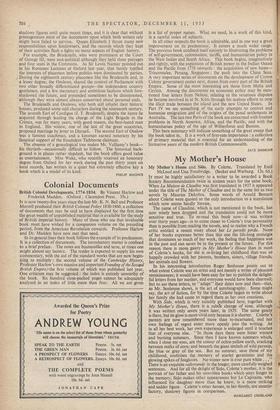My Mother's House
My Mother's House and Sido. By Colette. Translated by Enid McLeod and Una Troubridge. (Seeker and Warburg. 12s. 6d.) IT must be highly satisfactory to a writer to be awarded a Book Society Recommendation twice in sixteen years for the same book. When La Maison de Claudine was first translated in 1937 it appeared under the title of The Mother of Claudine and in the same list as two novels by Maurice Dekobra. Some words of Arnold Bennett about Colette were quoted as the only introduction to a translation which now seems hardly literate.
The name of Claudine, which is not mentioned in the book, has now wisely been dropped and the translation could not be more sensitive and true. To re-read this book now—it was written over thirty years ago—is to come closer to Colette's true personality than is possible from reading the novels, and to realise why a French critic entitled a recent essay about her Le paradis perdu. None of her books expresses better than this one the life-long nostalgia that dominates so much of her work, the feeling that happiness was in the past and can never be in the present or the future. For this reason there is more gaiety in. My Mother's House than in most of Colette's books, for she is re-living her childhood that- was so happily crowded with her parents, brothers, sisters, village friends, her animals and flowers.
In his interesting introduction Roger Senhouse points out to what extent Colette was an artist and not merely a writer of pleasant reminiscences; it would have been easy for her to publish the delight- ful letters from her mother, and everyone would have been charmed; but to use these letters, to "adapt" their dates now and then—that, as Mr. Senhouse shows, is the art of autobiography. Some might say, the art of fiction, for by the time Colette began to write about her family she had come to regard them as her own creations. With Sido, which is very suitably published here, together with My Mother's House, there is a subtle change of tone, although it was written only seven years later, in 1929. The same gaiety is there, but its glow is more vivid only because it is shorter. Colette's parents are now remembered more than re-incarnated, and her own feelings of regret enter more openly into the writing. As in all her best work, her own experience is enlarged until it touches that of everyone else. "In those days there were bitter winters and burning summers. Since then I have known summers which, when I close my eyes, are the colour of ochre-yellow earth, cracking between stalks of corn; and beneath the giant umbels of wild parsnip, the blue or grey of the sea. But no summer, save those of my childhood, enshrines the memory of scarlet geraniums and the glowing spikes of foxgloves. No winter now is ever pure white ..." There is an exquisite rallentando in the longer, more carefully weighed sentences. And for all the delight of Sido, Colette's mother, it is the portrait of her father and his unwritten books which stays longer in the memory; Sido makes other appearances but Le Capitaine, who influenced his daughter more than he knew, is a more striking and sadder figure. Colette's other heroes, in her novels, are unsatis- factory, shadowy figures in comparison.
MARGARET CROSLAND


































 Previous page
Previous page